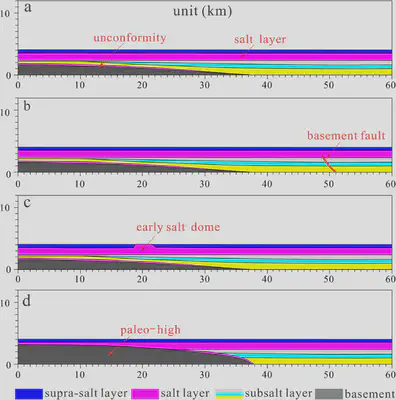Formation Mechanism of Salt Piercement Structures in a Compressive Environment A Case Study from the Kuqa Depression, Tarim Basin
The formation mechanism of piercement structures is more complex than that of concealed piercement structures, and current research on this issue is limited. Based on field geological outcrop surveys and detailed interpretation of seismic data, combined with the evolution of the tectonic-sedimentary environment and growth strata characteristics, this paper analyzes the distribution, geometry, and evolutionary history of salt piercement structures in the Kuqa Depression. On this basis, the influence of several possible factors on the formation and evolution of piercement structures is discussed through discrete element numerical simulation experiments. The results show that the salt piercement structures in the Kuqa Depression are mainly developed in the northern margin of the Wensu Uplift, the Quele passive salt diapir, and at the top of pre-existing basement faults in the Kelasu area. Salt rocks can directly pierce the overlying strata or contact the surrounding rocks through faulting. Growth strata characteristics indicate that the piercement structures in the Kelasu area formed earlier, followed by those in the northern Wensu margin, with the Quele piercement structures forming latest. The evolution of piercement structures can be divided into three stages: stable, weak compression, and strong compression. In a compressive environment, it is difficult for salt layers to form piercement structures relying solely on compressive stress. The edges of uplifts, early passive salt diapirs, the tops of pre-existing basement faults, and the fronts of sedimentary wedges are preferential locations for the development of piercement structures. The confinement of paleo-uplifts, reactivation of basement faults, preferential activity of early passive salt domes, and the progradation of the orogenic belt towards the basin interior are important inducing factors for the development of piercement structures. The crucial way these factors induce piercement structures is by promoting strong thrusting in suprasalt strata, thereby providing channels for salt upwelling.(Yang et al.,2024)。
[Yang, K., Qi, J., Shen, F., Sun, T., Duan, Z., Cui, M., ... & Lv, J. (2024). Formation mechanism of salt piercement structures in a compressive environment: An example from the Kuqa depression, western China. Journal of Structural Geology, 178, 105005.](https://doi.org/10.1016/j.jsg.2023.105005) #### TitleFormation mechanism of salt piercement structures in a compressive environment: An example from the Kuqa depression, western China
Keji Yanga, Jiafu Qib, Fangle Shenc*,Liangwei Xud, Tong Suna, Zhanzhan Duan c, Meijuan Cuie,Li Penge, Ji Lve
a. Hebei Key Laboratory of Strategic Critical Mineral Resources, Hebei GEO University, Shijiazhuang 050031, China b. State Key Laboratory of Petroleum Resources and Prospecting, China University of Petroleum, Changping, Beijing 102249, China c. Huaxin College of Hebei GEO University, Shijiazhuang 050000, China d. PetroChina Dagang Oilfield Exploration and Development Research Institute, Tianjin, 300280, China e. Bureau of Geophysics Prospecting Inc., CNPC, Research Center of Geology, Zhuozhou 072750, China
Abstract
The formation mechanism of piercement structures is more complex than that of concealed piercement structures, and little research has been conducted on this topic. In this work, based on surveys of field geological outcrops and detailed interpretation of seismic data, combined with the evolution of the tectonic-sedimentary environment and stratum growth characteristics, the geometry and evolutionary history of salt piercement structures in the Kuqa Depression are investigated. Through discrete element numerical simulation experiments, the influences of various factors on the formation and evolution of the piercement structure are discussed. The results show that the piercement structures in the Kuqa Depression are mainly developed in the northern margin of the Wensu paleohigh, the Quele passive salt diapir, and at the top of the Kelasu basement fault. The salt can directly pierce the overlying strata or contact the surrounding rock through faulting. The characteristics of the growth strata reveal that the Kelasu piercement structure formed first, followed by the Wenshu piercement structure, and the Quele piercement structure formed later. The evolution of the piercement structure can be divided into three stages: quiet, weak compression and strong compression. Relying solely on tectonic compressive stress, it is difficult for salt layer to form piercement structures. The most advantageous location for the development of the piercement structure in a compressive environment is in the margin of the paleohighs and low bulges and at the top of early passive salt diapirs and preexisting basement faults. The front of the sedimentary wedges is also a preferential location for the development of piercement structures. The barrier of the paleo-high, reactivation of the preexisting basement fault, priority activation of the early passive salt dome, and progradation of the sedimentary wedge from the orogenic belt to the basin interior are favorable factors inducing piercement structure formation. An important mechanism for controlling salt piercement is to promote strong thrusting in suprasalt strata, which provides a channel for salt upwelling.

Fig. 3. Numerical simulation experiment model setup: (a) basic model, (b) basement fault model, (c) preexisting salt dome model, and (d) paleo-high model. The initial setting of the progradation model is consistent with the basic model.

Fig. 14. Comparisons of numerical simulation experimental results and seismic profiles crossing the piercement structures in the Kuqa depression. The results show that there is a significant similarity between the experimental results and seismic data.
Translator: Bao Xianjun